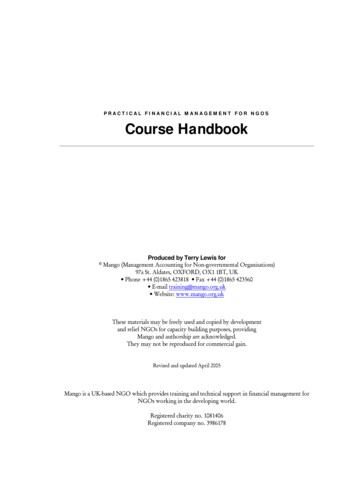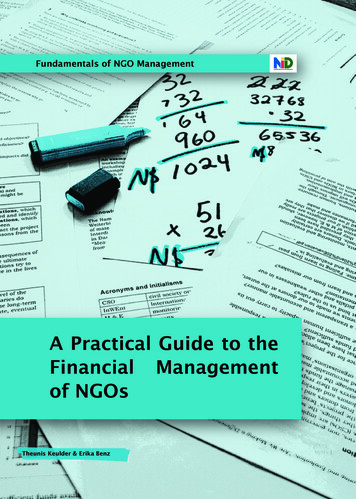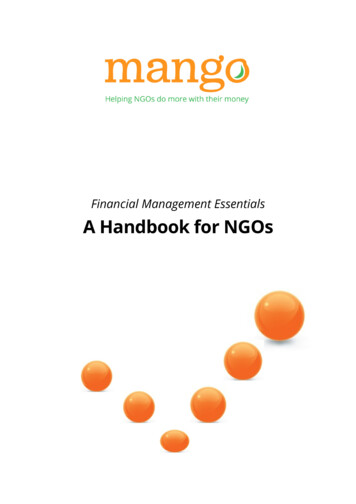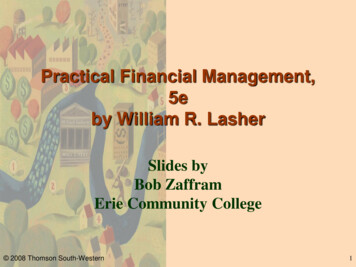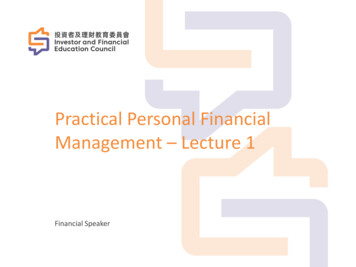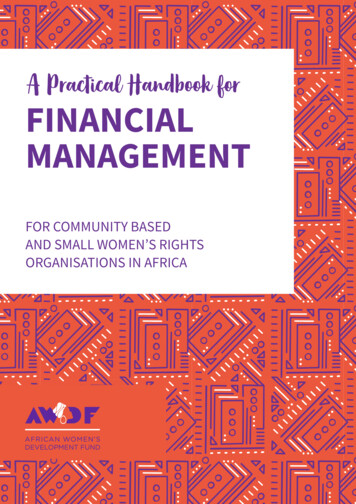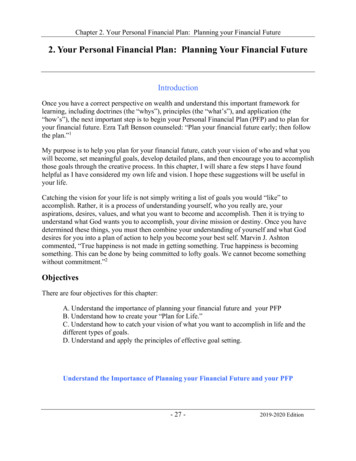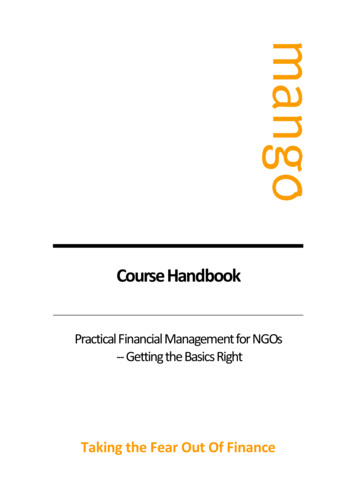
Transcription
Course HandbookPractical Financial Management for NGOs-- Getting the Basics RightTaking the Fear Out Of Finance
Practical Financial Management for NGOs – Getting the Basics RightCourse HandbookProduced by Terry Lewis for Mango (Management Accounting for Non-governmental Organisations)2nd Floor East, Chester House, George Street, Oxford OX1 2AU Phone 44 (0)1865 423818 Fax 44 (0)1865 423560 E-mail training@mango.org.uk Website: www.mango.org.ukRevised December 2009These materials may be freely used and copied by development and humanitarianorganisations for capacity building purposes, providing Mango and authorshipare acknowledged. They may not be reproduced for commercial gain.Mango is an award-winning UK-based charity which provides financial management training, professionalsupport and free resources for humanitarian and development non-governmental organisations.Registered charity no. 1081406Registered company no. 3986178
Table of ContentsGlossary1 FINANCIAL MANAGEMENT FOR NGOSi1Why is Financial Management important for NGOs?1So what is Financial Management?2What is Financial Control?4Who is Responsible for Financial Management?4The Seven Principles of Financial Management9The Four Building Blocks of Financial Management10The Tools of Financial Management122 GETTING ORGANISED13Systems Design13Financial Accounting vs. Management Accounting 14The Right System?15The Chart of Accounts15Cost Centres16Cost Structures18Financial Policies and Procedures18What is a Finance Manual?20Standard Forms21Work Planning213 FINANCIAL PLANNINGThe Financial Planning ProcessWhat is a Budget?Who needs Budgets?Types of BudgetBudget StructuresBudgeting TechniquesTop Down or Bottom up?Summary of Budget TerminologyThe Budgeting ProcessGood Practice in BudgetingUsing a Budget WorksheetSummary: What makes a good budget?The Challenge of Core CostsThe Challenge of Multiple Donor Programmes4 UNDERSTANDING ACCOUNTSWhy Keep Accounts?Accounting Methods232325262629293031323335373839414142Which Accounting Records to KeepSupporting DocumentationBank Book BasicsPetty Cash BookFull Bookkeeping SystemsWhat is a Trial Balance?What are Financial Statements?The Income and Expenditure ReportThe Balance SheetWhat is Depreciation?Accounting for Shared Costs5 FINANCIAL REPORTSIntroductionWho Needs Financial Reports?What are the Annual Accounts?Interpreting Financial StatementsRatio Analysis – Quick Reference FormulasManagement ReportingThe Cashflow ReportThe Budget Monitoring ReportForecast ReportsAnalysing Budget Monitoring ReportsVariance Analysis techniquesAction PlanningReporting to Donor AgenciesPresenting Financial ReportsReporting to BeneficiariesSummary: Twenty Questions6 SAFEGUARDING YOUR ASSETSManaging Internal RiskDelegated AuthoritySeparation of DutiesThe Procurement ProcessThe Reconciliation ProcessCash ControlPhysical ControlsTop Tips on the Warning Signs of FraudDealing with Fraud and Irregularities Mango 707273757677777879808284858890
7 MANAGING AUDITWhat is an Audit?Internal AuditExternal AuditSummary: Different Types of AuditWhat Does the Auditor Need?USEFUL REFERENCES93939494979899APPENDICES Mango 2009
Mango FM1 Course HandbookGlossaryAccountA record of monetary transactions, either written into a bookdesigned for the purpose or entered onto a computer file.Account codeA code for a specific type of transaction. Transactions are given acode which describes what type of income or expenditure theyare, eg 5050 Transport costs, 5600 Office rent etc.Accounting periodA specified period for recording and reporting financial activity fora given time, eg one year or one month.AccrualAdjustment made at the end of an accounting period to recogniseexpenses that have been incurred during the period but for whichno invoice has yet been received.Accumulated fundsMoney, or equipment, that we build up year by year as a result ofnot spending all our income. Often referred to as our Reserves.Acid testThe ratio achieved by dividing Current Assets (excl. Stocks) byCurrent Liabilities. It tells us if the organisation has sufficient fundsto pay off its debts immediately.ApportionmentThe sharing of indirect costs between two or more cost centres inproportion to the estimated benefit received.AssetAny possession or claim on others which is of value to theorganisation. See also Fixed Assets and Current Assets.AuditA formal check on the accounts by an independent person(auditor).Audit trailThe ability to follow the course of any reported transactionthrough an organisation’s accounting systems.AuthorisationThis is the process of approval over transactions, normally thedecision to purchase or commit expenditure. Authorisation by abudget holder is a way of confirming that spending is in line withbudget and is appropriate.Back donorThe original source of funds, where a grant is channelled throughan agency, such as an international NGO, on to an implementingpartner. The agency must report back to the original donor toaccount for the use of the funds by the local partner.Balance SheetA summary of the financial position of an organisation at aparticular date, showing the assets owned by the organisation andthe liabilities (or debts) owed to others.Bank bookA register which records all transactions passing through a bankaccount. Also known as a cashbook or a Cash Analysis Book. Mango 2009i
Mango FM1 Course HandbookBank reconciliationThe process of comparing the entries and ending balance in thecashbook with the bank statement, and identifying anydifferences. It provides an important check on the completenessand accuracy of the cashbook entries.BudgetA best estimate of the amount of money that an organisationplans to raise and spend for a set purpose over a given period oftime.Budget holderThe individual who holds the authority and has the responsibilityfor managing, a budget for a specified activity, project,programme, department or organisation.Burn rateExpressed as a percentage, the amount of a grant or budget usedup so far. Also known as the Utilisation Ratio.Capital expenditureExpenditure on equipment, property and other fixed assets whichwill be used to support activities over more than one accountingperiod.Capital fundAccumulated funds and reserves held in the form of equipmentand property.CashbookA book or spreadsheet that lists all of the receipts and paymentsmade in to and out of a particular bank or cash account.Cash reconciliationComparing the month end physical cash counted to the expectedmonth end balance in the petty cashbook.CashflowThe difference between cash received and cash spent in a period.Cashflow forecastA report that shows the expected timing of receipts and paymentsfor the next 3-6 months (or longer).Chart of accountsA list of all the accounts codes and cost centre codes that are usedin an organisation’s accounting system, with a description of each.Core costsCentral support costs shared by many projects. Also calledoverheads or indirect costs.Cost centreA way of distinguishing between different activities or projects todefine where costs are incurred or income is ‘earned’. Costcentres are closely linked to the concept of budget-holders.CreditorAnyone the organisation owes money to.Current assetsCash and other short-term assets in the process of being turnedback into cash – eg debtors. They can, in theory, be convertedinto cash within one year.Current liabilitiesShort-term sources of ‘finance’ (eg from suppliers, bank overdraft)awaiting payment in the next 12 months.Current ratioA measure of liquidity obtained by dividing Current Assets byCurrent Liabilities. It tells us if the organisation is able to pay offits debts within 12 months.DebtorAny person or other party who owes money to the organisation.ii Mango 2009
Mango FM1 Course HandbookDepreciationA proportion of the original cost of a fixed asset which is internallycharged as an expense to the organisation in the Income &Expenditure Account.Designated fundsUnrestricted funds which have been accumulated over time andearmarked for a particular purpose by the Trustees.Direct costA cost which can be specifically allocated to an activity,department or project.Donation in kindWhere a grant or contribution to a project is made in the form ofgoods or services, rather than a cash grant or donation.Double entrybookkeepingThe method of recording financial transactions whereby everyitem is entered as a debit in one account and a correspondingcredit in another.Exception reportA short narrative report which highlights significant variancesand/or areas for concern to accompany the managementaccounts.External auditA review of the year-end financial statements carried out by aprofessionally qualified and legally registered auditor resulting inan opinion about whether they give a true and fair view.Financial accountingRecording, classifying and sorting historical financial data,resulting in financial statements for those external to theorganisation.Fixed assetAn item of high value owned by the organisation for use over along period. Normally office equipment, vehicles and property.Fixed assets registerA list of the Fixed Assets of the organisation, usually giving detailsof value, serial numbers, location, purchase date, etc.Fund accountingUsed to identify spending according to the different projects orpurpose for which the funds were granted.General ledgerThe main accounting record where double-entry bookkeeping isused. See also Nominal Ledger.General fundsUnrestricted funds which have not been earmarked and whichmay be used generally to further the organisation’s objectives.Often referred to as Reserves.ImprestA type of cash float, set at an agreed level, which is topped up bythe exact amount spent since it was last reimbursed, to bring itback to its original level.Income & ExpenditureAccountSummarises income and expenditure transactions for theaccounting period, adjusting for transactions that are not yetcomplete or took place in a different accounting period.Indirect costA cost which cannot be specifically assigned to one activity,department or project, eg the fee for the annual audit.Journal entryAn entry in the books of account which covers a non-monetarytransaction – eg for recording a donation in kind or an adjustmentfor correcting a recording error. Mango 2009iii
Mango FM1 Course HandbookLiabilitiesAmounts owed by the organisation to others, including grantsreceived in advance, loans, accruals and outstanding invoices.LiquidityThe level of cash and assets readily convertible to cash comparedto the demands on the available cash., eg to pay bills.Liquidity ratioA measure of liquidity obtained by dividing debtors, cash andshort-term investments by current liabilities.Management accountingThe provision of financial information to management for thepurposes of planning, decision-making, and monitoring andcontrolling performance.Net book value (NBV)The cost of an asset less its accumulated depreciation to date.Net current assetsFunds available for conducting day-to-day operations of theorganisation. Usually defined as current assets less currentliabilities. Also known as working capital.Nominal accountA ‘page’ or ‘container’ in the Nominal Ledger for recording everytype of financial transaction likely to occur in an organisation,within a specified time period. A complete list appears in theChart of Accounts, each with its unique ‘nominal code’.Nominal ledgerA book or computer programme which holds details of each of thenominal accounts. Also known as General Ledger.OrganogramOrganisation chart showing the management and departmentalstructure of the organisationPayment voucherAn internal document raised for each payment. It provides aunique reference number and evidence of authorisation.Supporting documents are attached to it.Petty cash bookThe day-to-day listing of petty cash paid out.PrepaymentsAmounts paid in advance at a particular accounting period – egannual insurance premium.ProcurementThe process of purchasing goods and services. Steps in theprocess may include requesting, authorising, selecting suppliers,ordering, receiving and paying.Quarter / quarterlyThree months of the accounting year, eg Quarter 1 (or Q1) wouldbe 1 January to 31 March where the financial year runs fromJanuary to December.Receipts & PaymentsaccountA summary of the cash book for the period with opening andclosing balances.ReconciliationChecking mechanism which verifies the integrity of different partsof an accounting system. Especially balancing the cash book to thebank statement.ReservesFunds set aside from surpluses produced in previous years.Restricted fundsIncome which has conditions attached to how used, usually with arequirement to report back to the donor.iv Mango 2009
Mango FM1 Course HandbookSignatoriesPeople who are authorised to sign cheques on behalf of theorganisation.Statutory deductionAmounts which must be taken from an employee’s pay beforethey receive it, such as income tax or national insurancecontributions.Supporting documentThe original documents that describe each transaction. These mayinclude, receipts, invoices, delivery notes, sign sheets etcTransactionAny exchange of goods, services or money in return for othergoods, services or money. Most commonly receipts and payments.Trial balanceThe list of debit and credit balances on individual nominalaccounts from which an income and expenditure statement isprepared.TrusteeA member of an NGO’s most senior governing body, who sharesoverall responsibility for the NGOs work.Unrestricted fundsFunds held for the general purposes of the organisation, forspending within the stated objectives.VarianceThe difference between the budget and the actual amount ofincome or expenditure.VirementThe ability to transfer from one budget heading to another.Working advanceA sum of money entrusted to someone to spend on behalf of theorganisation, which needs to be accounted for.Working capitalSee Net Curre
Practical Financial Management for NGOs – Getting the Basics Right Course Handbook Produced by Terry Lewis for Mango (Management Accounting for Non-governmental Organisations) 2nd Floor
